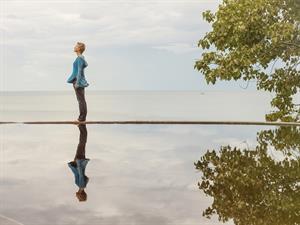PDF chapter test TRY NOW
The path of light is changed when it is illuminated on a shining smooth or polished surface. For example, a stainless steel plate or a steel spoon can act as a mirror and change the direction of light. Even the surface of still water behaves like a mirror by reflecting the images of trees or buildings.

The bouncing of light from a smooth or shiny surface is called reflection. Smooth polished surfaces or shiny surfaces called mirrors can reflect light falling on them in any direction. The reflection from a mirror gives a clear image of an object.

Reflection of light by a mirror
This activity shows the reflection of light by a plane mirror using a torch, a small mirror, a chart and a wooden board.

- The glass cover of the torch is closed with a black chart.
- Three thin slits are made at the centre of the chart.
- A sheet of the chart is placed on the wooden board above which the plane mirror is fixed vertically.
- The torch with the slits is turned on and allowed the light beam to fall on the mirror.
- The torch is also positioned such that the light falls on the chart placed on the wooden board.
- Now, the position of the torch is adjusted at an angle to make the beam of light fall on plane mirror.
Observation
The mirror changes the direction of the light falling on it. Again, when the torch is slightly moved to either side, there is a change in the direction of the reflected light from the mirror.
Archimedes mirror
Archimedes, a Greek scientist, used mirrors as weapons around two thousand years ago. This technique was used in a coastal city in Greece named Syracuse when attacked by Romans. The mirrors were arranged in their coastal area such that they can be moved in any direction. They also adjusted the mirror's position to reflect the sunlight on the Roman soldiers to confuse them. The Roman soldiers were dazzled and ran away.

